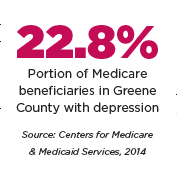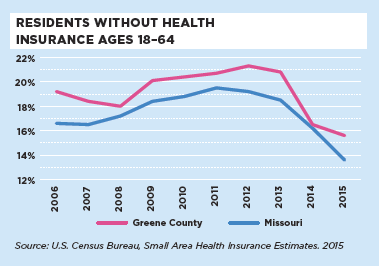


Collaborative studies and surveys highlight an increasingly united regional health care community, which is engaging key problems for underserved populations.
The Springfield-Greene County area is tackling health issues with an innovative and collaborative spirit with unprecedented partnership and alignment.
Our community serves as a regional hub for health care services with two world-class health systems, CoxHealth and Mercy , anchoring the delivery of health care in our community. These systems take a collaborative approach when pursuing opportunities to combat health issues, as evidenced by the Community Health Needs Assessment and the Community Health Improvement Plan that was produced in 2016 in conjunction with the Springfield-Greene County Health Department.
Throughout this process, it became clear that mental health issues, including substance abuse, are among the greatest health challenges for our community to understand and treat. Mental health issues are closely connected to so many other health conditions and are exacerbated by coexisting conditions, including tobacco use, and are further complicated by access and availability of treatment. A concerted effort to better understand and develop a plan to improve mental health in our community was identified as a priority for attention over the next three years.

In July 2016, the Springfield-Greene County Health Department, CoxHealth and Mercy health systems published a collaborative Community Health Needs Assessment (CHNA), the most coordinated and comprehensive health assessment for the Springfield community conducted to date. The assessment evaluated primary and secondary data to identify top health concerns for the community. It also compared local data with state and national indicators, and included community readiness and feasibility for change.
Through this process, the following three priority health issues for the Springfield area were identified:
A Community Health Improvement Plan (CHIP) was developed and adopted by community partners through the Healthy Living Alliance (HLA) in August 2016 to improve factors influencing the identified priority areas. The CHIP, which is divided into five domains (access to appropriate care, social determinants of health, mental health, tobacco use, and healthy eating and active living) and consists of 22 objectives focused on policy and system change, is the action plan for next three years to improve lung disease, cardiovascular disease and mental health.

The data analysis identified several common areas to target:
The Institute of Medicine describes social determinants as "conditions in the environments in which people are born, live, learn, work, play, worship, and age that affect a wide range of health, functioning, and quality-of-life outcomes and risks."
In general, these determinants — which include unemployment, poverty, and education level — affect the decisions people make because of the policies in place that guide their actions and people's access to resources and opportunities that contribute to a long, healthy life. As these red flags are reviewed, it is important to consider the environmental conditions in which people live so that sustainable, long-lasting interventions can reduce and prevent chronic health issues.
According to the most recent U.S. Surgeon General's report published in 2014, smoking causes 87 percent of all lung cancer deaths, 32 percent of deaths due to coronary heart disease, and is responsible for 79 percent of all cases of chronic obstructive pulmonary disease. In Missouri, 23 percent of adults use tobacco, compared with 18 percent nationally. Within the Springfield community, tobacco use has gradually decreased from 24 percent in 2011 but has hovered around 21 percent the past three years.
To reduce the threat of death and poor quality of life among residents in the Springfield area, it is imperative that efforts are taken to reduce tobacco use. Policy initiatives should be taken at both the state and local levels. Missouri has the lowest tobacco tax rate in the nation at 17 cents per pack. At least a $1 tax increase is needed to reduce smoking rates. At the local level, increasing the minimum age of legal sale from 18 to 21 years old would reduce tobacco rates by preventing initiation at a young age. Additionally, implementing smoke-free housing policies would protect families from secondhand smoke.
 A grave concern validated through the Community Health Needs Assessment is the need to seek alternatives to providing treatment for mental health issues through our emergency departments and our criminal justice system. In the Springfield area, which includes Greene, Christian and Webster counties in this analysis, 20.5 percent of Medicare beneficiaries suffer from depression and 12.8 percent of adults drink excessively. There are also 14.14 deaths per 100,000 people. Additionally, out of the top six health priorities studied in the health assessment, mental illness (nearly 20 percent of visits) in the amount of emergency department visits. Throughout the Community Health Needs Assessment, it became clear that more information is needed to fully understand the scope of the issue and factors causing mental illness. Therefore, a thorough community mental health needs assessment should be conducted.
A grave concern validated through the Community Health Needs Assessment is the need to seek alternatives to providing treatment for mental health issues through our emergency departments and our criminal justice system. In the Springfield area, which includes Greene, Christian and Webster counties in this analysis, 20.5 percent of Medicare beneficiaries suffer from depression and 12.8 percent of adults drink excessively. There are also 14.14 deaths per 100,000 people. Additionally, out of the top six health priorities studied in the health assessment, mental illness (nearly 20 percent of visits) in the amount of emergency department visits. Throughout the Community Health Needs Assessment, it became clear that more information is needed to fully understand the scope of the issue and factors causing mental illness. Therefore, a thorough community mental health needs assessment should be conducted.
 Despite numerous efforts, access to appropriate health care remains a concern for many. Nearly 21 percent — an estimated 50,491 people — remain without health insurance in the Springfield area. Efforts to improve access to care should focus on improving the systems around the individual to improve health and access to appropriate care, and work to modify the way that individuals consume health services to ensure care is effective and efficient. One initiative that should be considered is a comprehensive referral system that directs people to appropriate care.
Despite numerous efforts, access to appropriate health care remains a concern for many. Nearly 21 percent — an estimated 50,491 people — remain without health insurance in the Springfield area. Efforts to improve access to care should focus on improving the systems around the individual to improve health and access to appropriate care, and work to modify the way that individuals consume health services to ensure care is effective and efficient. One initiative that should be considered is a comprehensive referral system that directs people to appropriate care.
The federal Centers for Disease Control and Prevention reports that obesity rates in America have increased from 35 percent in 2011-2012 to 38 percent in 2013-2014. Within the Springfield area, 29 percent of adults are obese, which has increased from 28 percent in 2006. According to the CDC, chronic diseases are responsible for seven out of 10 deaths each year and account for 86 percent of our nation's health care costs. Policy and system level interventions have the greatest impact in reductions of the prevalence of obesity rates. Policy changes at the local level should include active transportation planning, incorporate health considerations in land use and growth management plans, create healthier workplaces through wellness initiatives, and improve access to healthy food.
Students at Missouri State University gathered input from the Springfield citizens via Padlet. Respondents raised issues with regard to uninsured residents and overloaded medical professionals.
"We have struggled to put our arms around what the impact of mental illness is on our community. … The mental health assessment will provide us the best strategy to pull in all the tiles of the mosaic so we can get a clear picture and establish a path forward."
— CLAY GODDARD
ASSISTANT DIRECTOR
SPRINGFIELD-GREENE COUNTY HEALTH DEPARTMENT
For current information on community health indicators, including mental health care services and insurance access, visit CARES Engagement Network.